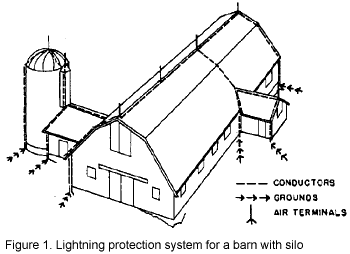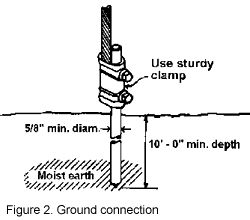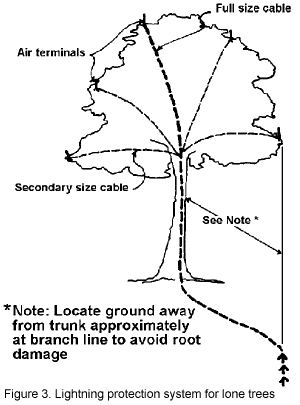Lightning is the leading cause of farm fires. Plan 6368 illustrates some appropriate arrangements for lightning protection for farm buildings. A well-installed and maintained lightning protection system (see Figure 1) routes lightning along a known, controlled course between the air and moist earth with over 90 percent effectiveness in preventing damage. Such systems can prevent damage to a building or any loss of income related to this damage.

Lightning protection systems consist of five parts: 1) air terminals, 2) conductors, 3) ground connections, 4) bonding, and 5) arrestors.

 Livestock often are killed when they are near a fence or tree
that receives a lightning discharge. Wire fences need to be
grounded. Use galvanized steel posts at 150-foot intervals
along the fence. It also is recommended that long runs of
wire fence be interrupted. Lone trees should be either fenced
off to keep livestock away from them or be protected by a
lightning protection system (see Figure 3).
Livestock often are killed when they are near a fence or tree
that receives a lightning discharge. Wire fences need to be
grounded. Use galvanized steel posts at 150-foot intervals
along the fence. It also is recommended that long runs of
wire fence be interrupted. Lone trees should be either fenced
off to keep livestock away from them or be protected by a
lightning protection system (see Figure 3).
In an approved lightning protection system the house, barns, sheds, silo and all other buildings are protected. All metal tracks, guys, lines and other metal bodies are bonded to the system as required. Arrestors are installed where needed. Lone trees are protected. Metal fences are properly grounded. Electrical entrance services have Underwriters Laboratory (UL) approved arrestors.
Local fire officials should be contacted for conformance with local codes as may apply. Only reputable contractors should be used. The recommendation on the plan incorporates, with permission, the 1983 recommendations of the lightning Protection Institute (LPI), 46 North Ayer, Harvard, IL 60033. LPI has a lightning system certification program and certifies journeymen installers, master installers and professional designer inspectors.
For
more copies of this plan, contact your county Extension agent
or agricultural engineer at your landgrant university. If
you do not know the location of your State university, send
your request to Agricultural Engineer, Extension Service,
U.S. Department of Agriculture, Washington, D.C. 20250. Your
request will be forwarded to the correct university.
Publication #: 29
Pennsylvania Cooperative Extension Service. For more information, contact Pennsylvania State University College of Agricultural Sciences, Agricultural Engineering Department, 246 Agricultural Engineering Building, University Park, PA 16802.
Dennis J. Murphy, professor, Agricultural Engineering Department, Cooperative Extension Service, Pennsylvania State University, University Park, PA 16802.
Disclaimer and Reproduction Information: Information in NASD does not represent NIOSH policy. Information included in NASD appears by permission of the author and/or copyright holder. More